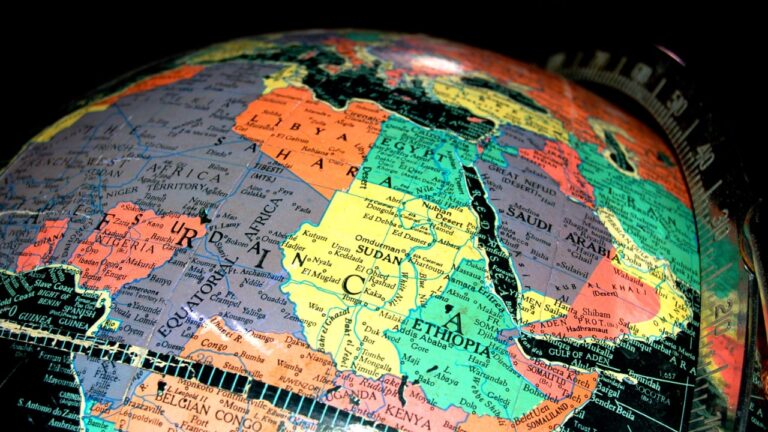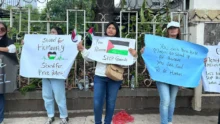The Middle East and Terrorism in Historical Records

The Middle East is one of the areas that the world pays attention to, because of its strategic location between three continents, namely Asia, Africa, and Europe. This automatically makes the Middle East a connecting region of the three continents and a center for the global trade. In addition, several countries in the Middle East region are adjacent to the sea and straits and have abundant oil potential, many countries outside the region want to cooperate and import oil for the benefit of their country.
But on the one hand, the Middle East is a region that has quite large problems and challenges, one of the problems faced by this region is terrorism and Islamic extremism. Many groups have emerged whose attack patterns are increasingly extreme, such as the Al-Qaeda group and the ISIS group, which are considered the largest terrorist groups and spread in many areas. The emergence of terrorist groups in the Middle East is due to many factors.
Prakoso Pramono, a researcher in the field of terrorism as well as a Doctoral student of the University of Indonesia’s Terrorism Study Program, explained that the emergence of terrorist groups in various countries is caused by multiple factors.
Not only in the Middle East, this applies in general in many regions such as Southeast Asia and Africa for example. Theoretically, terrorist groups emerge and develop due to responses to failed governments, crises, and conflicts.
Al-Qaeda, the organization led by Osama bin Laden, was originally established as a network of groups to support Afghan Muslims who at that time were facing war with the Soviet Union, and to reduce or prevent outside influence from Islamic interests. In its development this group then spread and established branches in Sudan under the protection of the Taliban militia. From here, this group aims to shake international security, and legitimize Western culture and values.
Al-Qaeda has become an international terrorist group and has networks or branches in various countries, such as the Al-Qaeda Abu Sayyaf Group (ASG) based in the Philippines, Al-Qaeda the Islamic Maghreb (AQIM) based in Algeria, Al-Qaeda in the Arabian Peninsula (AQAP) affiliates in Yemen and Saudi Arabia, Al-Qaeda in Iran and Jabhat al-Nusra based in Syria.
In addition to Al-Qaeda, the terrorist group that is developing in the Middle East is ISIS/ISIL (The Islamic State in Iraq and Syria/The Islamic State in Iraq and the Levant). ISIS is led by Abu Bakr Al-Baghdadi and has vision to create a country based on Islamic law. With a radical and rigid understanding of religious teachings, this group attacked and killed hundreds of people and had carried out more than 140 terror attacks in 29 countries besides Iraq and Syria, and became one of the most powerful and feared terrorist groups, because of its success in seizing various power area.
However, during the ongoing military operations by the Iraqi and Syrian military forces and the US-led coalition forces in several areas in the Middle East, the Islamic State of Iraq and Syria (ISIS) is believed to have lost important power bases in the region. The killing of several important ISIS leaders, such as Abu Muhammad al-Adnani, who is known as an important actor behind the propaganda of terrorist networks scattered in various countries, made the group lose potential cadres who had a significant influence.
Based on data released by defense analysts IHS, since the increase in attacks carried out by the Iraqi and Syrian government camps in retaking their territory through ground and air military operations in early 2015, the Islamic State jihadist group has lost about 28% of its territory. By nine months of 2016, they had lost territory from 30, 115 square miles to 25,290 square miles, the equivalent of Sri Lanka. In addition to losing their territory in Mosul, the success of the SDF (Syrian Democratic Forces) forces recaptured 90% of the Raqqa area which at that time became the heart of the ISIS jihadist force in Syria at the end of 2017.
After Abu Bakr Al-Baghdadi suffered many defeats and lost territory in the Middle East opened the opportunity for an end to violence. However, ISIS propaganda that has spread widely and has spawned jihadist networks in various regions outside the Middle East has the potential to be used to expand the jihad agenda and establish an Islamic State in new areas.
One area that has great potential to become a target for expanding the jihad agenda is Southeast Asia.
Apart from the fact that this area has long been known as a base for terrorist movements and radical Islamic militant groups such as Jamaah Islamiyah (JI) and al-Qaeda, in recent developments ISIS has also declared a local wing network from Southeast Asia known as ‘Katibah Nusantara‘. It is planned that the network will not only be used for recruiting purposes and facilitate the sending of prisoners to Iraq and Syria, but also be prepared to organize attacks in several countries in the Southeast Asia Region, such as Indonesia, Malaysia, Singapore and the Philippines.
Terrorism in Southeast Asia
In the context of the threat of terrorism in Southeast Asia, this region has long been known as a base for radical Islamic militant groups as well as a global terrorist network. Referringto the explanation in the U.S. Congressional Research Service in 2009 regarding the movement of radical Islamic groups in Southeast Asia at the beginning of its development, the pattern of movement of radical Islamic groups in this region only focused on domestic issues in each country and the network relationships formed between groups. militant in this area tends to be weak.
However, after the 1990s, where the trend of globalization has brought many changes in the global contestation, radical Islamic groups have begun to find momentum to expand their movement outside the region. The issues they focus on are also broader, such as strong criticism of Israel’s occupation of Gaza, disillusionment with secular government policies, rising anti-Western sentiment that can be attributed to the large influence of the United States in the region, as well as increasing awareness to strengthen network in the region by establishing “Pan-Islam” in Southeast Asia.
Furthermore, Prakoso argues that in addition to being influenced by global factors, there are also local factors that cause terrorists to develop in Southeast Asia, “In the context of Indonesia, for example, it has a distinctive history with Darul Islam (DI)/Indonesian Islamic State (NII), its peculiarity is because because its emergence was not much influenced by foreign countries, Kartosuwiryo emerged with disappointment and political interest,” he said.
In Moro, Philippines, terrorist groups emerged because of economic disparities, as well as the spirit of independence for the Moro Nation, which identity clashed. “Meanwhile, the global influencing factor is when people in Southeast Asia are busy going to Afghanistan to study, with radical figures in various regions of the Middle East, and joining the mujahideen as combatants, this is where the network begins to form”, explained Prakoso.
Still, In the Indonesian context, for example, Prof. Dr. Istidiyantha, Professor of Middle East Studies, explained that the birth of Darul Islam and the Masjumi Party in Indonesia can be traced from their relationship with Islamic movement networks in the Middle East, “and they also have an intensive relationship, so that Islamic movements are categorized as radical and terrorist. in Indonesia did not appear suddenly, but through a long process”, he stressed.
Based on data published by CNN, the departure of several Indonesians and Malaysians to join Abu Bakar Al-Baghdadi’s troops was quite significant. In early 2016, there were around 700 Indonesian fighters who went to Syria along with 200 Malaysians.
This proves that the propaganda and efforts of Middle Eastern terrorist groups in Southeast Asia have appeal. Therefore, it is not surprising that concerns about the threat of Middle Eastern theorists that began to spread since mid-2014 have become one of the important issues for security dynamics in Southeast Asia today. This concern arises from several facts that show that this area has become part of the ISIS and Al-Qaeda network and has contributed significantly in supporting the strength of the militant forces.
Next, another fact that is predicted to increase the potential presence of ISIS in Southeast Asia is the support of jihadist sympathizers from both individuals (lone wolves) and local wing networks in the region that have been affiliated and supported the struggle for the establishment of the Islamic State.
The return of several ISIS fighters from Iraq and Syria to their respective countries of origin due to the defeat suffered, and the increasing sentiment between groups with ethnic backgrounds and religious beliefs in several countries in Southeast Asia in recent times, are some of the factors that can be used by terrorist groups as propaganda material to open conflicts.
It is undeniable, as an area inhabited by 15% of the world’s Muslim population with various sects and sects, including Muslim fundamentalist and extremist activists, Southeast Asia is a very vulnerable area to propaganda and influence from radical Islamic militant groups.
The 2016 IPAC (Institute for Policy Analysis and Conflict) report states that cooperation between Middle Eastern terrorist groups and Southeast Asian terrorist groups is increasingly accelerating the threat of the expansion of the Islamic State in Southeast Asia, and to achieve this goal local terrorist groups such as the Abu Sayyaf (ASG), Ansarul Khilafa Philippines (AKP), the Maute group in Lanao del Sur, and the Bangsamoro Islamic Freedom Fighters (BIFF) were provided with training facilities, weapons, advanced communication tools, as well as additional knowledge of combat strategies by fighters from the Middle East/outside the region (Foreign Fighters).
Prakoso emphasized that the beneficiaries of this local terrorist group need to be distinguished, “there are two main terms that need to be clear, there is a group called pro and there is a group called affiliation, these two groups are different, if the affiliate group has direct ties, their communication is intense,” He said.
“In the case in Indonesia, for example, the pro group will seek funding by their own group, because this method is considered the easiest than having large funds to enter the country, which of course is risky for their group,” said Prakoso.
Actually, in terms of funding, Southeast Asian terrorist groups operate like franchises, and operate autonomously, which is expected to shift the world’s attention to other regions, so that in the Middle East they can regroup.
“For example, in the case of Jamaah Islamiyah, they divided the area into several mantiqi, covering several areas in Southeast Asia including Singapore, Malaysia, the Philippines. The pro-ISIS group movement is also the same, related between groups in Indonesia and the Philippines. Everything is networked,” he added.
All of these linked terrorist groups have one agenda in common, namely the Islamic State/Daesh “Daulatul Islam baqiyah wa tatamaddad“, an eternal and expanding Islamic state. This is their agenda of both terrorist groups in the Middle East, ISIS in Europe and South East Asia. However, their methods are different, there are insurgent groups who want to separate themselves from the sovereign entity of the state by using acts of terrorism, there are groups that seek martyrdom through continuous acts of terror.
According to Prakoso, theoretically, their strategies are qital nikayah and qital tamkin. One is trying to do attain martyrdom with continuous acts of terror, with one cell triggering another, creating chaos. And one is strategically trying to take action with momentum, starting from I’dadpreparing for war, physical training, camping, climbing mountains, looking for funding for charities, distributing charity boxes, stealing from gas stations and grocery stores, and after that , infiltrate / create educational institutions.
If it is broken down to the level of small groups or even individuals, the agenda will be different. There are individuals who join terrorist groups because of ideological calls, are radicalized from their families, want to help Muslims in other countries (generally those who take the hijrah route) and so on.
“The black flag of ISIS flying in the southern Philippines along with the suicide bombing in Jakarta in early 2017 indicates that there are greater challenges for countries in Southeast Asia in dealing with global terrorism, where the main premise is interconnection with one another. It is necessary to strengthen security cooperation in the ASEAN region (Association of South East Asian Nations) to deal with terrorist threats in Southeast Asia,” he concluded.



